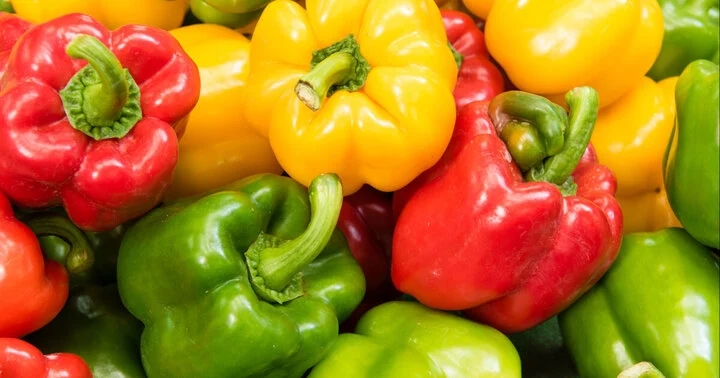Bell peppers are used to create many delicious dishes and provide numerous health benefits. The vibrant color of bell peppers is a sign that they contain valuable nutrients, making them a staple in healthy menus. They help fight aging and prevent diseases.
Are bell peppers with 3 lobes or 4 lobes tastier?
Some people refer to bell peppers with 3 lobes as male bell peppers, and those with 4 lobes as female bell peppers. According to them, female bell peppers have more seeds but are sweeter and tastier when eaten raw, while male bell peppers are tastier when cooked.
In fact, from a scientific perspective, bell peppers do not have a gender; the distinction lies in the flowers. According to James Wong, an English botanist, “Bell pepper flowers have both male and female parts, but bell peppers themselves are genderless.”
Allen Van Deynze, Director of the Seed Biotechnology Center and Associate Director of the Plant Breeding Center at the University of California, explains that “Bell pepper flowers are called bisexual flowers, having both male and female parts in the same flower. The fruit itself originates from the female ovary (like all other types of fruit) but carries the genetic combination of both the father and the mother (DNA) in its seeds.”

The terms male and female bell peppers are simply colloquialisms. (Photo: Chef Gourmet LLC)
Therefore, male and female bell peppers, distinguished by the number of lobes on the fruit, are just colloquial terms. But is it true that female bell peppers with 4 lobes are tastier? Allen Van Deynze states, “The number of lobes on a bell pepper is related to the variety, genetics, and cultivation conditions. Sweetness usually depends on the ripeness of the pepper, and red peppers tend to be sweeter than green peppers.”
According to him, the number of lobes on a bell pepper does not determine its taste. Different bell pepper varieties will produce different numbers of lobes. Some varieties have two lobes, while others have three to five lobes. The most common bell pepper variety in the US has 4 lobes.

Do bell peppers with 3 lobes or 4 lobes taste better? The number of lobes on a bell pepper does not determine its taste. (Photo: Heidi’s Bored)
The taste and sweetness of bell peppers are not related to the number of lobes on the fruit. Besides ripeness, this factor is also influenced by the plant variety, soil, and weather conditions.
Whether a bell pepper has three or four lobes, it will taste sweeter when fully ripe, with a deep-colored skin, such as dark green, deep yellow, or red. Therefore, when choosing bell peppers, you should select fruits that are fully ripe, with smooth, shiny, vibrant, and evenly colored skins.
The stem of the bell pepper should be fresh and firmly attached to the fruit, and when holding the bell pepper, it should feel firm in your hand. Avoid selecting fruits that are soft, have blemishes on the skin, or have cracked or missing stems.
Benefits of bell peppers
In his article in the Health & Life newspaper, PhD Dr. Le Thanh Hai states that bell peppers are rich in vitamin A, vitamin C, and other nutrients.
Green bell peppers provide 551 IU of vitamin A per 149 grams, equivalent to a small cup. Red bell peppers have even more of this vitamin, which helps maintain healthy vision. A small cup of any color bell pepper provides over 100% of the daily requirement of vitamin C, which has antioxidant effects and supports the health of cells and the immune system.
Bell peppers also provide folate, which supports the function of red blood cells and prevents certain congenital defects in fetuses. This fruit is a rich source of vitamin K, which is essential for blood clotting function, and is also rich in potassium, which helps strengthen muscle function and regulate blood pressure. A cup of green bell pepper contains 261 mg of potassium, while red and yellow varieties provide over 300 mg.
Red bell peppers are rich in phytochemicals and carotenoids, especially beta-carotene, which has antioxidant and anti-inflammatory effects.
The capsaicin in bell peppers reduces bad cholesterol, controls diabetes, and reduces pain and inflammation. The fiber content of bell peppers helps regulate digestion and cholesterol levels.

Bell peppers provide many health benefits. (Photo: CFAES)
Lycopene, a type of carotenoid in red bell peppers, helps fight free radicals and prevent certain types of cancer, especially prostate cancer in men. Yellow and orange bell peppers are also rich in carotenoids, which can protect the cardiovascular system.
All bell pepper varieties are rich in vitamin E, which plays an important role in keeping the skin and hair youthful.
Vitamin B6 in bell peppers is essential for the health of the nervous system and cell regeneration. Some enzymes, such as lutein, protect the eyes from cataracts and macular degeneration.
According to VTC news






























